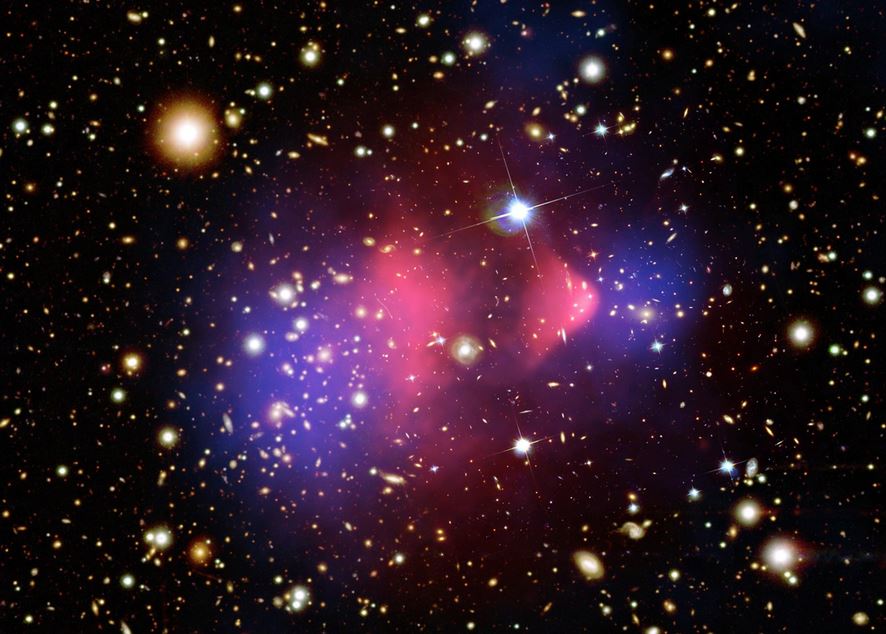When an international team of scientists observed multiple collisions between huge clusters of galaxies, they were amazed to discover that dark matter coasts straight through the turmoil unscathed. Dark matter appears not to interact with anything, they commented.
Dark matter is an enigma. Most of our Universe’s matter is believed to consist of it. We know it is there, but cannot see it, and it does not correspond to anything in the realm of our experience.
Theories regarding dark matter abound and compete with each other for an explanation, but as yet none of them has prevailed.

The ‘Bullet Cluster’ – dark matter shown in purple (Image Credit: NASA, STSCI, U.Arizona, ESO)
Scientists at École Polytechnique Fédérale de Lausanne, Observatoire de Sauverny (Switzerland), Durham University (England), University College London (England), and the University of Edinburgh (Scotland) have studied how dark matter behaves when galaxy clusters collide over billions of years. They published their findings in the academic journal Science (citation below).
Galaxy clusters and dark matter
Scientists know very little about dark matter, even though it accounts for most of the Universe’s matter and over one quarter of its energy.
Many astronomers believe dark matter is made of a subatomic particle we have not yet discovered. Some wonder whether it might be a quantum defect from the birth of the Universe, a modified form of gravity, or a type of extra-dimensional mass.
We know dark matter exists – it interacts with cosmic structures through gravity, molding and shaping them. Dark matter bends light that passes through it – it distorts images of distant space objects.
We also know that dark matter accelerates the movement of galaxies within galaxy clusters. Galaxy clusters are collections of hundreds of galaxies which contain literally astronomical amounts of gases, planets and stars.
Galaxy clusters are ideal environments for studying dark matter, given that it makes up most of their matter, especially when they crash into each other and force their respective dark matter to interact.
72 galaxy collisions studied
David Harvey, who works at EPFL’s Laboratory of Astrophysics, studies galaxy cluster collisions to gain insight into the nature of dark matter. Harvey and colleagues gathered and analyzed data from seventy-two galaxy cluster collisions.
These cosmic collisions occur over billions of years when galaxy clusters are pulled towards each other because of their colossal masses. When they crash into each other, the dark matter in each galaxy interacts with that of the other, providing a unique opportunity to study it.
In this study, the data came from the Hubble telescope and the Chandra X-ray Space Observatory, and included the famous Bullet Cluster collision – a collision between two galaxy clusters whose gas has become molded into the shape of a giant bullet.
Astronomers say this collision provides the best current evidence that dark matter exists.
Harvey and colleagues analyzed the collision data to determine whether the momentum of dark matter changed when the two galaxy cluster collided.
According to experiments on Earth, as with the Large Hadron Collider, when subatomic particles interact they exchange momentum. Therefore, depending on what happened to the dark matter after the collision, the researchers would be able to draw conclusions about its nature.
To test the theory that dark matter is made up of particles, the researchers worked with two possible scenarios: either the dark matter particles interacted frequently but little momentum was exchanged, or they interacted rarely but a lot of momentum was exchanged.
In the first case, the frequent particle interactions would have caused an additional ‘drag’, thus slowing down the dark matter after the collision.
In the second scenario, dark matter would have scattered away and vanished into space.
Respective dark matters completely unaffected
The scientists were surprised to find that the respective dark matters in galaxy cluster collisions simply passed through each other and emerged unscathed, suggesting that their particles did not interact with each other.
The researchers wrote “It appears that while dark matter could interact ‘non-gravitationally’ with visible matter, this is not the case when it interacts with itself.”
Prof. Andy Taylor, from the School of Physics and Astronomy at The University of Edinburgh, said:
“We expected to find that dark matter had minimal interaction with other objects, but we were surprised at how dark and elusive it seems to be.”
This study challenges the view that dark matter is made up of proton-like particles, or any type of particles.
“We have now pushed the probability of two ‘dark matter particles’ interacting below the probability of two actual protons interacting, which means that dark matter is unlikely to consist of just ‘dark-protons’. If it did, we would expect to see them ‘bounce’ off each other.”
Citation: “The nongravitational interactions of dark matter in colliding galaxy clusters,” David Harvey, Richard Massey, Thomas Kitching, Andy Taylor and Eric Tittley. Science. Published 27 March, 2015. DOI: 10.1126/science.1261381.

